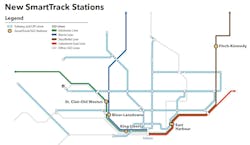Ontario, Toronto revise agreement for SmartTrack Stations Program
The Greater Toronto Area is one step closer to growing by five GO rail stations following the signing of a revised “Ontario-Toronto Agreement in Principle” by the government of Ontario and city of Toronto.
The agreement endorses the SmartTrack Stations Program where funding from the province and city will utilize Metrolinx’s GO rail infrastructure in Toronto to remake the regional commuter service into an urban rapid transit network.
Metrolinx says each of the four stations it is starting procurement on will be managed as an individual procurement and contract, and requests for proposals are expected to be released this August and awarded in the fall of 2021.
Ontario Associate Minister of Transportation Stan Cho explains transit maps have not always kept pace with growth of the Greater Toronto Area, but the revised agreement is looking to break that pattern.
“When these five stations open, it will be good news for everyone. Workers will spend less time communing; parents will be home quicker to their families; and Jays fans will make it to the Rogers Centre easier,” said Associate Minister Cho.
Metrolinx notes the five SmartTrack stations will join other new GO stations in Toronto, four new subway lines (Scarborough, Ontario Line, Yonge North and the Eglinton Crosstown West Extension) and two new light-rail transit lines (Finch West and the Eglinton Crosstown), to completely rewrite Toronto’s transit map, transforming how Torontonians move through the city.
“As travel patterns change, we know how important it is for Torontonians to be able to use transit to get around their city. In collaboration with the province of Ontario and the city of Toronto, we are pleased to enable the use of GO Transit’s rail infrastructure to build stations that will further enhance this city’s transit network,” said Metrolinx CEO Phil Verster.
Toronto Mayor John Tory recognizes that this level of investment and significant enhancement to the area’s transit network would not be possible without cooperation between the municipality and province.
“We know that we cannot deliver vital transit projects on our own. By working with the other levels of government we can ensure that we are moving quickly to expand our transit system, relieve congestion, increase transit accessibility and create new economic and employment opportunities for residents,” said Mayor Tory.
The city of Toronto estimates the service improvements from the SmartTrack Stations Program will provide walkable access to rail service for 83,000 residents and 91,000 jobs. The five new stations are projected to bring approximately 110,000 new daily riders by 2031 to the rail network and reduce congestion on the roads and emissions throughout the region.
About the Author

Mischa Wanek-Libman
Group Editorial Director
Mischa Wanek-Libman is director of communications with Transdev North America. She has more than 20 years of experience working in the transportation industry covering construction projects, engineering challenges, transit and rail operations and best practices.
Wanek-Libman has held top editorial positions at freight rail and public transportation business-to-business publications including as editor-in-chief and editorial director of Mass Transit from 2018-2024. She has been recognized for editorial excellence through her individual work, as well as for collaborative content.
She is an active member of the American Public Transportation Association's Marketing and Communications Committee and served 14 years as a Board Observer on the National Railroad Construction and Maintenance Association (NRC) Board of Directors.
She is a graduate of Drake University in Des Moines, Iowa, where she earned a Bachelor of Arts degree in Journalism and Mass Communication.

